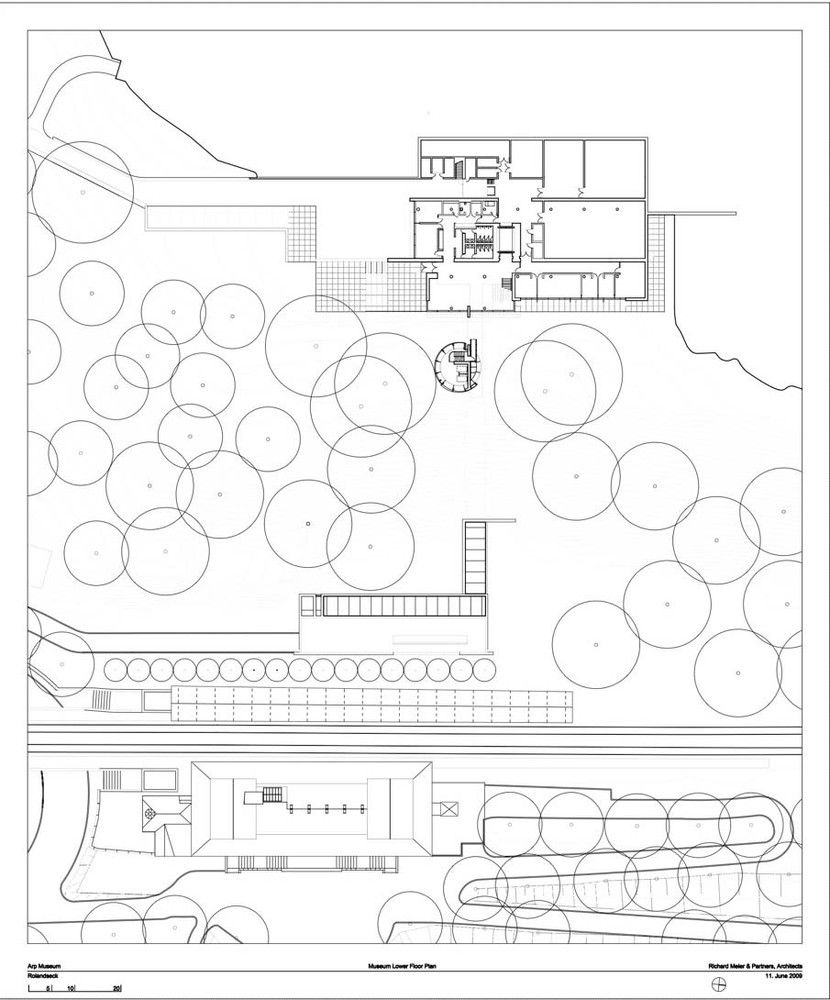The design of the Arp Museum represents the seamless integration of the building’s spectacular site with the museum’s mission to showcase the work of the Dadaist master Hans Arp and his circle. One of the unique features of the region in which the museum is located is the series of medieval castles that line a 35-mile stretch of the river Rhine. The Arp Museum, sited on a wooded escarpment overlooking the Rhine, is intended to respond to and echo the forms of these captivating relics.
The structure’s entry sequence does not begin in the Museum proper, but rather at the base of the bank-side mountain, in the old village railway station, used since the 1960s as an exhibition space. The lowest level of the station functions as the main entrance to the new museum building, which is reached only gradually by a series of carefully modulated tunnels and shafts that burrow into and up through the mountain to the new building.
The first of these subterranean sequences begins from this lobby, which leads to a 40-meter-long tunnel—illuminated by two continuous bands of light—that extends below ground under the railway tracks to an exhibition pavilion that stands independent of the main museum building. The modest pavilion features polished concrete floors and a discreet slotted skylight; aside from providing ancillary temporary exhibition space, the pavilion also establishes a sense of expectation and uncertainty that is further reinforced by the next sequence, which materializes as another subterranean tunnel, this time 35 meters long and terminating at the bottom of a dramatic 40-meter-high shaft with access to two glass-enclosed elevators. These elevators ascend through the shaft to a conical tower structure above grade. Here the translucent tower walls illuminate the shaft and elevators, with added illumination and hints of views provided by transparent glass slots in the tower walls. At the tower’s apex the elevators open onto a 16-meter-long, glass-enclosed bridge which represents the final stage of the sequential promenade into the Museum.
The entry to the museum’s ground floor is flanked to the right by a freestanding staircase leading to the lower and upper levels and to the left by a void overlooking the lower-level lobby. In addition to the lobby, which offers visitors an opportunity for rest and repose, the lower level features a classroom, administrative offices, service facilities, and access for shipping and receiving art. In fact, the oversized service elevator, designed to facilitate the movement of art, also functions as the visitors’ elevator and provides a galvanizing core around which the gallery spaces on the ground and upper floors are organized. More specifically, at the ground level these spaces include two large galleries with access to two terraces, as well as a smaller enclosed gallery. The spaces on the upper floor are distributed in the same manner as on the ground floor; however, rather than opening onto terraces, the two large galleries on the upper floor occupy a seemingly free-floating platform supported by columns so that they overlook the ground floor galleries at the east and west edges. The two main upper-level galleries are illuminated from above by a ceiling composed almost entirely of glazing, with a series of 2-foot-wide adjustable aluminum louvers providing complete daylight or daylight modulated with artificial light. A similar, though immobile, louver system occupies the double-height glazed facade facing the Rhine, opening the museum to breathtaking views of the surrounding valley.
The design of the Arp Museum represents a unique and seamless integration of history, art, architecture and nature. The hillside siting, amongst a gathering of medieval castles, with the landmark railway at the Rhine’s bank side presented a challenge and opportunity to bring a modern texture to the historical fabric of Rolandseck.
The use of the railroad station as a portal and the design of the entry sequence is integral to this ideal of relationships between interior and exterior, past and present. Traveling through the exhibition spaces within the rail station, through the tunnels and shafts into the tower and over the bridge makes the experience of entry part of the museum experience as a whole. The double height glazed façade and translucent quality brings the light and extraordinary surroundings into the space as well.
Project info :
Architects: Richard Meier & Partners
photographs : Courtesy of Richard Meier & Partners Architects, Roland Halbe













